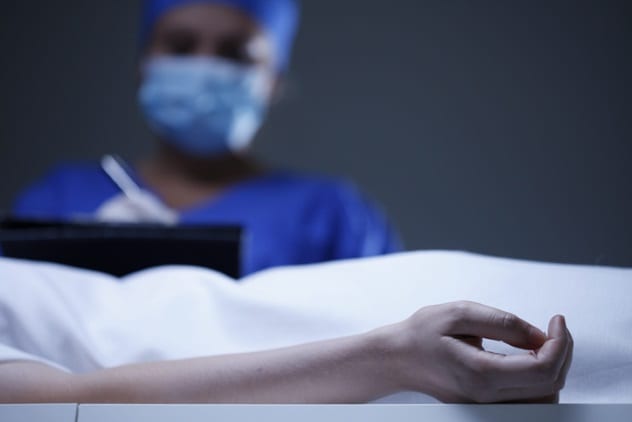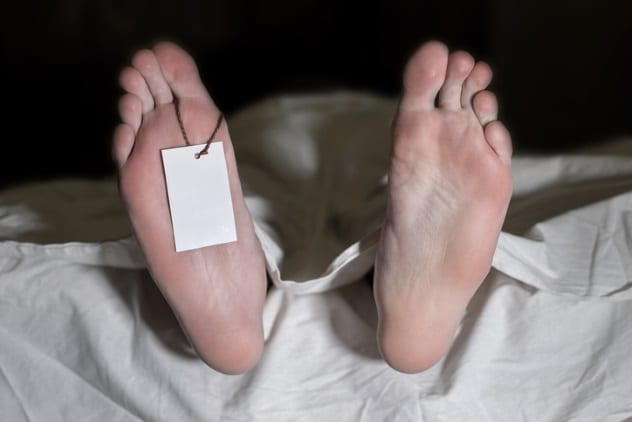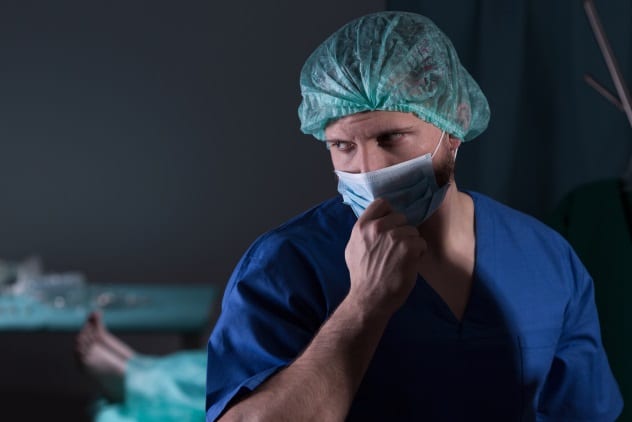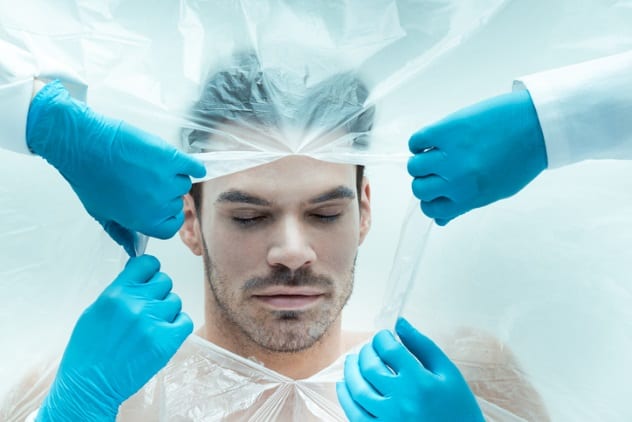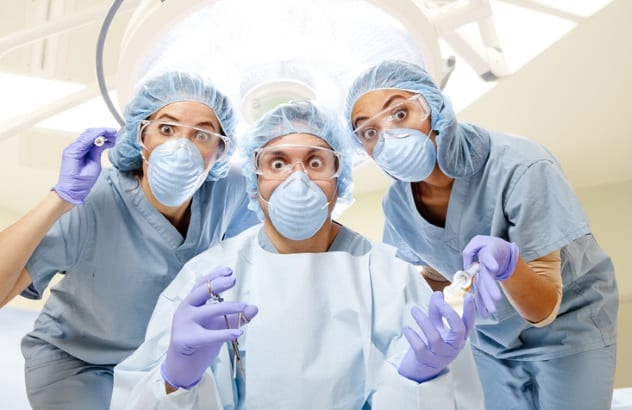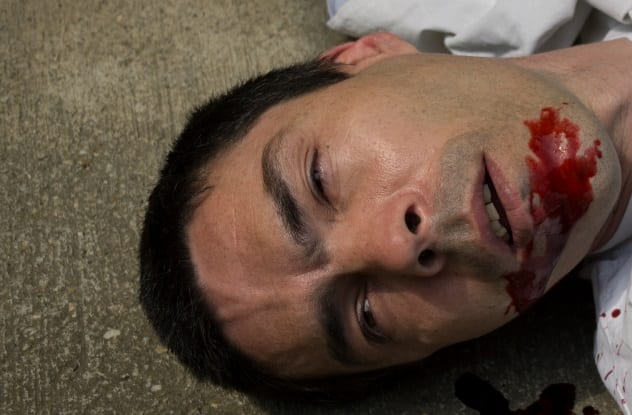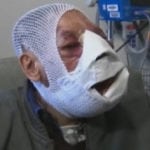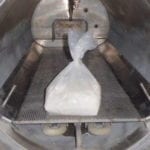SEE ALSO: Top 10 Ways To Dispose Of Your Body After Death Still, the things corpses can do are shocking and a bit creepy. From giving birth to an awareness that it’s dead, the changes that occur in the body after death seem almost too unrealistic to be true. The following list is not for the faint of heart—or stomach.
10 Move
Stories of dead bodies sitting straight up have been told for many years—yet the probability of such drastic movement occurring is slim to none. The body can, however, make slight movements after death. Though the movements do not resemble ones that a person would do while alive, they can still be startling for those around them. Cadavers can do such things as twitch, move, and even clench muscles. This occurs because the body’s muscles are still receiving nerve signals to contract or even relax, causing the corpse to appear as if it is moving despite being dead.[1] Once the adenosine triphosphate (ATP) is depleted, the body will make its final movements, which can be seen in fingers clenching, hands moving, toes wiggling, and muscles twitching. Another factor in strange movements is how the person died. If there is excess calcium, a temperature change, or, in some cases, violent death or even electrocution, the body can demonstrate such movements. This process normally occurs between the time of death and rigor mortis, so if anyone tells you they’ve seen a body sit up, they’re probably just trying to get a rise out of you.
9 Give Birth
Unfortunately, death does not have a moral compass, and anyone, even those who are pregnant, can fall victim to its embrace. Giving birth while alive is a beautiful experience; giving birth after one has died is the complete opposite, especially for those dealing with the dead body. These “births” are referred to as “coffin births” due to them happening inside coffins. Basically, the pressure of gases building up within the deceased pushes the fetus out. The fetus has to be positioned in just the right (or wrong) way for this to occur.[2] Even though most of these cases of coffin birth occurred during times without the benefits of modern medicine, they still happen to this day. In January 2018, a woman in South Africa, who had died suddenly ten days prior, shocked people at the funeral home when they saw that she had given birth inside her coffin. The woman had been nine months pregnant at the time of her death, and all arrangements for her funeral had been made when the staff made the spine-chilling discovery that her body had expelled the fetus after death.
8 Eliminate
During the process of death, the body goes through various changes. One of these is the relaxation of every muscle, including those which control certain bodily functions, such as the elimination of urine and feces. Postmortem elimination is due to the sphincter muscles in the body relaxing. As the brain dies, it no longer sends the signals to keep these muscles contracted, and the contents left in the bowels and bladder will end up being released. [3] These bodily functions do not always happen after death; it depends on how you die and how much food and liquid are in your bladder and bowels before death. In the case of ill patients, there may not be as much food in their system due to the lack of appetite that can accompany illness. However, in cases of sudden death, bodies are more likely to release whatever was left in their system. The process can take a few hours, though, so it’s best to let nature take its course on this one.
7 Make Noise
Most depictions of dead bodies moaning and groaning focus on zombies rather than the actual dead. However, while corpses aren’t likely to scream or yell, they are likely to make noises such as moans, groans, hisses, and grunts.[4] These bodies aren’t making this noise voluntarily, of course. When cadavers are moved after death, the air still left inside the windpipe will escape and vibrate the vocal cords, making noises similar to grunts and moans. These sounds have spurred the horror stories of dead bodies making noise, though the reality is less horrifying. The sounds can often happen when coroners or morticians are prepping or turning the body over; the air will escape, causing what appears similar to human sounds but are just the simple result of the rest of the lungs’ contents leaving. Another way these noises can occur is when the gases in the body begin to build up. They can escape through the windpipe, causing squeaks, hisses, and sometimes lower groaning.
6 Illusions Of Growth
Even though someone has been ruled dead, it may take time for the body to fully cease functioning. Once the brain shuts down, the body follows, but some have claimed that though the body is no longer alive, the hair and nails continue to grow. As horrifying as that sounds, the truth is that the hair and nails only appear to have grown. When a body dies, it no longer has a supply of oxygen, making it impossible for glucose, which stimulates nail and hair growth, to be produced. What actually occurs is that the skin around the nails and hair begins to retract due to dehydration, making it appear that the nails and hair have grown longer, when in reality, they’re the same as they were before death. This also applies to men with stubble and hair on their chest; as the skin shrinks, the hair looks more prominent, making it seem as if the body has developed more stubble after death. Goosebumps after death due to contractions of the muscles in the skin can also impact how hair can appear.[5] In some circumstances, it will give the effect that the hair has grown longer, but once the contractions end, the hair will return back to its normal state. Those of you with hair, such as men with beards, shouldn’t worry. Funeral staff will moisturize bodies to decrease the look of dry skin.
5 Self-Digestion
After death, the body begins to decompose. It goes through a process in which it begins to digest itself—yes, essentially feeding on itself to aid in decomposition—through a process called autolysis. We still know very little about human decay, but the growth of forensic research facilities, or “body farms,” together with the availability and ever-decreasing cost of techniques such as DNA sequencing, now enables researchers to study the process in ways that were not possible just a few years ago. Soon after the heart stops beating, cells become deprived of oxygen, and their acidity increases as the toxic by-products of chemical reactions begin to accumulate inside them. Enzymes start to digest cell membranes and then leak out as the cells break down. This usually starts in the liver, which is enriched in enzymes, and in the brain, which has high water content; eventually, though, all other tissues and organs begin to break down in this way. Damaged blood cells spill out of broken vessels and, aided by gravity, settle in the capillaries and small veins, discoloring the skin. This is when the bacteria in our bodies come into play. Our bodies host huge numbers of bacteria, with by far, most residing in the gut, which is home to trillions of bacteria of hundreds or perhaps thousands of different species. Most internal organs are devoid of these microbes when we are alive. Soon after death, however, the immune system stops working, leaving them to spread throughout the body freely. This usually begins in the gut, at the junction between the small and large intestines. Left unchecked, our gut bacteria begin to digest the intestines and then the surrounding tissues from the inside out, using the chemical cocktail that leaks out of damaged cells as a food source.[6]
4 Explode
Tall tales have been told of bodies exploding from the inside out. Though this may seem a bit far-fetched, it isn’t too far from the truth—in a way. Spontaneous human combustion has been an explanation for many of these tales, but the reality is a bit different. When a body dies, its temperature usually drops. In some cases, the temperature actually increases, which is referred to as “postmortem hyperthermia.” This continuous increase in temperature can be caused by different things, from drugs to trauma to even signals in the brain before death. The body can continue to grow hotter, but the likelihood of actual combustion is low, as the temperature will begin to drop back down as the corpse goes into the regular stages of decomposition. Still, there have been cases of bodies exploding—although spontaneous human combustion isn’t responsible. What happens is that, as a body begins to break down after death, the gases inside (the same ones that can cause moaning and groaning) have to escape. The gases’ continuous buildup can lead to an “explosion” of bodily remains. This rarely happens. In January 2013, however, a corpse did explode in a mausoleum in Melbourne.[7] Those visiting the mausoleum bore witness to the event—and the smell. The experience was enough to traumatize witnesses and ensure that better precautions were taken to avoid another such incident.
3 Appear Aroused
Responding to certain stimuli when alive is natural and occurs even in the most inopportune of times. While it can be embarrassing if the moment isn’t right, it’s nothing near as creepy as a dead man getting an erection. Once the heart stops beating, all of the blood that was previously circulating begins to trickle down and collect at the lowest part of the body available. In some cases, depending on how the man died, such as those who have suffered a spinal injury or passed facedown, this can be in the genital area. The continuous pooling of blood is only natural, as is the reaction it causes in the dead man’s penis, referred to as priapism.[8] While this is uncommonly seen now, it can also happen with women. When a woman dies similarly, her labia can become enlarged, and her clitoris can swell.
2 Orgasm
Even though this sounds a lot like necrophilia, it thankfully isn’t. In corpses that no longer have oxygen pumping through them, this is unlikely ever to happen, but for those that are clinically dead but being used as beating-heart cadavers or as organ donors, the possibility of the body having an orgasm is there. This isn’t done on purpose. Doctors who work with these bodies sometimes have to trigger parts of the spine electrically. In some cases, when the sacral nerve root in the base of one’s spine is stimulated, it causes a reflexive reaction by the autonomic nervous system. Again, this only works because the bodies are still receiving oxygen, despite being clinically dead. When the doctors trigger this part of the spine, the reflex it causes in the system can result in an orgasm. However, because the body is clinically dead, no actual enjoyment or pleasure comes from this experience. The brain is no longer sending out signals, and while the body may react, it’s only doing so out of pure reflex.[9]
1 Know They’re Dead
There are countless stories of those who have come back from near-death experiences and have given their interpretation of what they believe the afterlife is like. While many are left to wonder what happens after we die, scientists may have at least part of an answer. Scientists have found that after death, the brain can retain some semblance of awareness. This means that after one has passed, they might actually be aware they’re dead. In a study of 2,060 cardiac arrest survivors who had been declared legally dead, meaning that they no longer had identifiable brain function, around 40 percent claimed they were still aware of their surroundings and conversations going on around them.[10] The period doesn’t seem to last long, research has found. As death is a process, the time between oxygen leaving the system and the brain sending its last signals can leave room for awareness. Scientists believe that there is an average time of 10–20 seconds of awareness after death. A severed head, for example, still produces EEG waves even after death, though a portion of these seconds have lead scientists to believe the brain enters a stage of unconsciousness. Still, the idea that a body may be aware that it’s dead is nothing short of unsettling.
